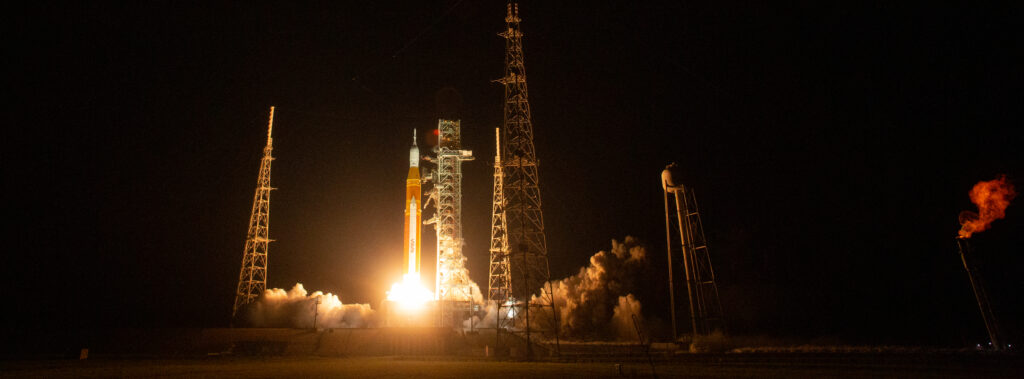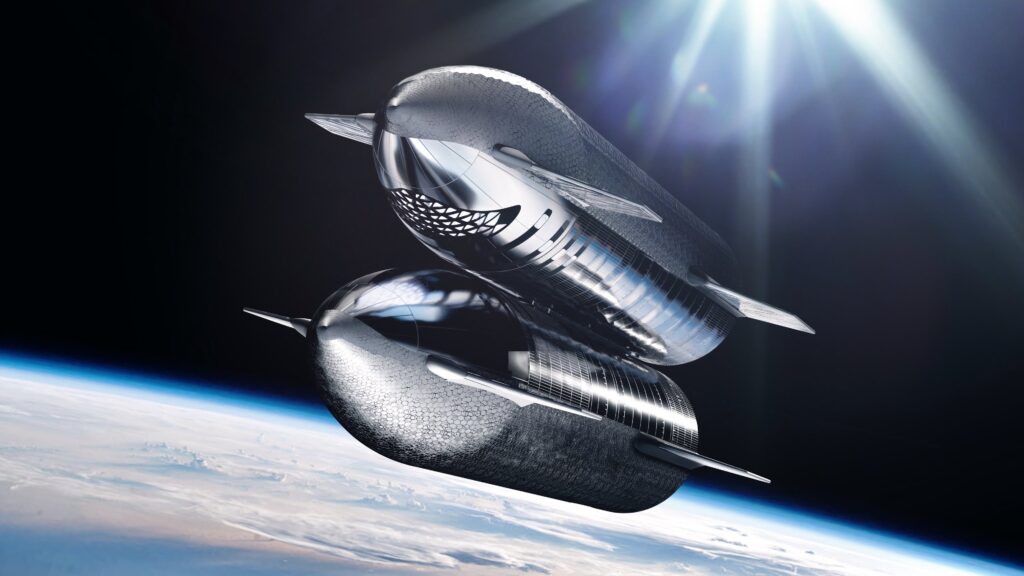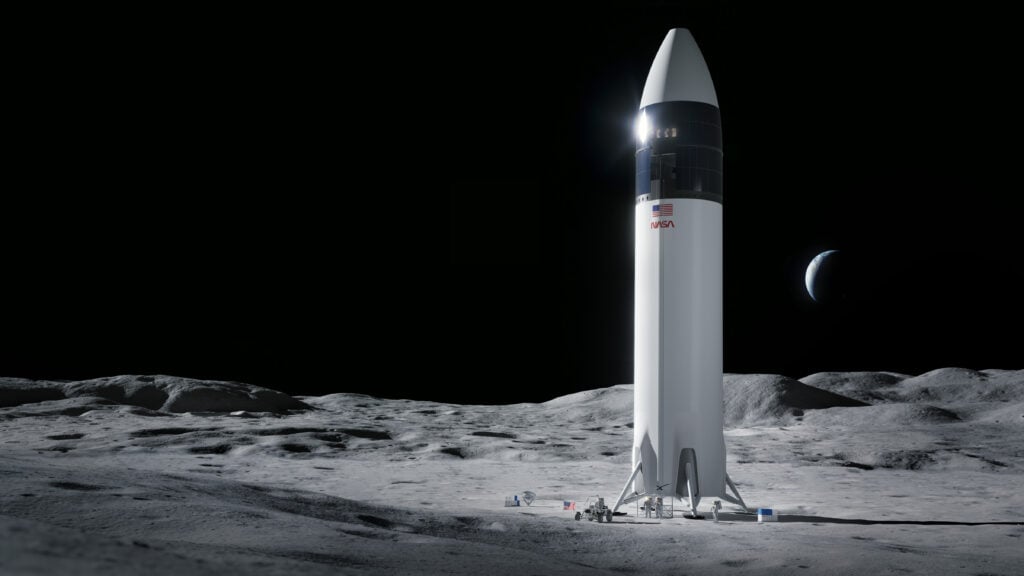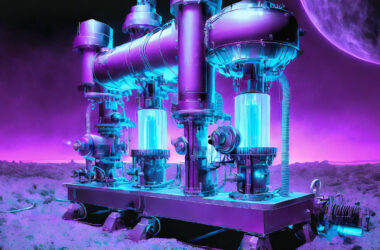The Artemis program, NASA’s ambitious initiative to return humans to the Moon, will achieve a significant milestone with the Artemis III mission in 2026.
This historic mission will mark the first crewed lunar landing since the Apollo era, over five decades ago. Artemis III aims to put boots on the Moon again and establish a sustainable presence on the lunar surface, paving the way for future exploration and eventual crewed missions to Mars.

NASA’s partnership with SpaceX, one of the leading commercial spaceflight companies, plays a crucial role in the Artemis III mission. SpaceX’s innovative Starship Human Landing System (HLS), a modified version of their reusable Starship spacecraft, will be instrumental in transporting astronauts from lunar orbit to the Moon’s surface and back. The collaboration between NASA and SpaceX exemplifies the growing trend of public-private partnerships in space exploration, combining the expertise and resources of both entities to achieve ambitious goals.
The Artemis III mission profile is complex and involves cutting-edge spacecraft, advanced propulsion systems, and state-of-the-art life support technologies. The mission will face numerous engineering challenges, such as developing reliable and efficient spacecraft, establishing robust communication and navigation systems, and creating sustainable habitation modules on the lunar surface.
Today, we do a deep dive into ten critical steps of the Artemis III mission, exploring the engineering that will enable this historic lunar landing. From the powerful Space Launch System (SLS) rocket that will propel the Orion spacecraft to the Moon to the innovative Starship HLS that will land astronauts on the lunar surface, we will examine the technological advancements and scientific objectives of each phase of the mission.
Artemis III Mission: 10 Steps to the 2026 Lunar Landing
01. Liftoff aboard NASA’s SLS mega-rocket
The Artemis III mission will kick off with the liftoff of the Orion spacecraft atop NASA’s Space Launch System (SLS) rocket from the Kennedy Space Center in Florida. The SLS, the most powerful rocket ever built, will generate an incredible 8.8 million pounds of thrust at liftoff, surpassing the Saturn V rocket used in the Apollo missions.
 NASA’s Space Launch System rocket carrying the Orion spacecraft launches on the Artemis I flight test, Wednesday, Nov. 16, 2022, from Launch Complex 39B at NASA’s Kennedy Space Center in Florida. NASA’s Artemis I mission is the first integrated flight test of the agency’s deep space exploration systems: the Orion spacecraft, Space Launch System (SLS) rocket, and ground systems. SLS and Orion launched at 1:47 a.m. EST, from Launch Pad 39B at the Kennedy Space Center. Photo Credit: (NASA/Joel Kowsky)
NASA’s Space Launch System rocket carrying the Orion spacecraft launches on the Artemis I flight test, Wednesday, Nov. 16, 2022, from Launch Complex 39B at NASA’s Kennedy Space Center in Florida. NASA’s Artemis I mission is the first integrated flight test of the agency’s deep space exploration systems: the Orion spacecraft, Space Launch System (SLS) rocket, and ground systems. SLS and Orion launched at 1:47 a.m. EST, from Launch Pad 39B at the Kennedy Space Center. Photo Credit: (NASA/Joel Kowsky)
This colossal rocket will propel the Orion spacecraft, carrying the Artemis III crew, into Earth’s orbit and set them on a trajectory towards the Moon.
The SLS rocket is a phenomenal piece of engineering, standing at a towering height of 322 feet (98 meters) and weighing 5.75 million pounds (2.6 million kilograms). Its core stage is powered by four RS-25 engines, derived from the Space Shuttle’s main engines, which have been upgraded for improved performance and reliability. The rocket also features two solid rocket boosters, providing additional thrust during the initial ascent phase.
The SLS’s power is essential for the Artemis III mission, as it must send the Orion spacecraft and its crew on a precise trajectory to reach the Moon. The rocket’s advanced avionics and guidance systems ensure accurate navigation and control throughout the launch sequence, while its innovative propulsion technologies enable efficient and reliable operation.
02. Orion flies the Artemis III crew to the Moon.
Once safely in Earth’s orbit, the Orion spacecraft will begin its four-day journey to the Moon. Orion is a state-of-the-art spacecraft designed to carry astronauts beyond low Earth orbit and support long-duration deep space missions. It consists of three main components: the crew module, the European Service Module (ESM), and the Launch Abort System (LAS).

The crew module, built by Lockheed Martin, is a capsule-shaped vessel that provides a safe and comfortable living space for the astronauts during their journey. It has advanced life support systems, communication devices, and navigation instruments to ensure the crew’s wellbeing and mission success. The ESM, developed by the European Space Agency (ESA), provides propulsion, power, and thermal control for the Orion spacecraft, enabling it to manoeuvre and maintain a stable environment for the crew.
During the four-day transit to the Moon, the Artemis III crew will monitor the spacecraft’s systems, conduct scientific experiments, and prepare for the upcoming lunar orbit insertion. Orion’s advanced guidance, navigation, and control systems will ensure a precise trajectory and make any necessary course corrections.
As Orion approaches the Moon, it will perform a series of complex manoeuvres to enter a Near Rectilinear Halo Orbit (NRHO) around the lunar body. This unique orbit, which has never been used in previous missions, offers a stable and energy-efficient path for the spacecraft to maintain its position relative to the Moon and Earth. The NRHO also provides an ideal staging point for the subsequent steps of the Artemis III mission, including the rendezvous with the Starship HLS and the lunar landing.
03. Uncrewed Starship HLS launches to the Moon.
While the Orion spacecraft carries the Artemis III crew to the Moon, SpaceX’s Starship Human Landing System (HLS) will launch separately into the lunar orbit. The Starship HLS is a modified version of SpaceX’s revolutionary Starship spacecraft, optimised for landing on the Moon’s surface and returning to lunar orbit.
The Starship HLS will launch from Earth using SpaceX’s Super Heavy booster, a powerful, reusable rocket designed to carry large payloads to orbit and beyond. The Super Heavy booster, standing at 230 feet (70 meters) tall and powered by 33 Raptor engines, will provide the thrust necessary to lift the Starship HLS from Earth’s surface and accelerate it towards the Moon.
Once in Earth’s orbit, the Starship HLS will separate from the Super Heavy booster and begin its solo journey to the Moon. The spacecraft will utilise its onboard Raptor engines to perform a series of propulsive manoeuvres, gradually raising its orbit and setting course for the lunar destination.
The uncrewed Starship HLS will be equipped with advanced sensors, navigation systems, and communication devices to ensure its safe and precise transit to the Moon. SpaceX’s mission control will closely monitor the spacecraft’s progress, making any necessary adjustments to its trajectory and systems as it traverses the vast expanse between Earth and the Moon.
As the Starship HLS approaches the Moon, it will perform a series of manoeuvres to slow down and enter a lunar orbit. The spacecraft’s innovative heat shield and thermal protection systems will protect it from the extreme temperatures and forces experienced during this mission phase.
04. Starship HLS refuels in Earth orbit.
Before its journey to the Moon, the Starship HLS will refuel in Earth’s orbit to ensure sufficient propellant for the lunar landing and ascent. SpaceX has been developing innovative propellant transfer technologies that will enable the Starship HLS to refuel in space, provide a critical capability for long-duration missions, and establish a sustainable presence on the Moon.

The propellant transfer process will involve a series of Starship tanker vehicles launched by SpaceX’s Super Heavy booster that will rendezvous with the Starship HLS in Earth’s orbit. These tanker vehicles will carry an ample supply of cryogenic propellants, such as liquid oxygen and liquid methane, which will be transferred to the Starship HLS through carefully orchestrated manoeuvres and docking procedures.
The refuelling process will utilise advanced cryogenic fluid management systems, ensuring the propellants remain stable and liquid throughout the transfer. Specialised docking adapters and fluid couplings will enable the safe and efficient transfer of propellants between the tanker vehicles and the Starship HLS.
SpaceX has been conducting testing for its propellant transfer technologies, including completing a Starship wet dress rehearsal and a static fire test. These tests have validated the feasibility and safety of the refuelling process, paving the way for its implementation in the Artemis III mission.
Refuelling the Starship HLS in Earth’s orbit is potentially a game-changing capability that will significantly extend the range and duration of lunar missions. By eliminating the need to carry all the necessary propellant from Earth’s surface, the Starship HLS can dedicate more of its payload capacity to scientific instruments, habitation modules, and other essential equipment for lunar exploration.
05. Starship HLS enters lunar orbit.
After refuelling in Earth’s orbit, the Starship HLS will begin its journey to the Moon. Utilising its powerful Raptor engines, the spacecraft will perform a series of propulsive manoeuvres to gradually raise its orbit and set course for the lunar destination.
As the Starship HLS approaches the Moon, it must perform a critical manoeuvre known as lunar orbit insertion (LOI). This manoeuvre involves firing the spacecraft’s engines in the opposite direction of its motion, slowing it down sufficiently to be captured by the Moon’s gravitational field. The precise timing and execution of the LOI manoeuvre are crucial, as any errors could result in the spacecraft crashing into the lunar surface or missing the Moon entirely.
The Starship HLS will rely on its advanced guidance, navigation, and control (GNC) systems to achieve a successful LOI. These systems, which include sensors, onboard computers, and software algorithms, will continuously monitor the spacecraft’s position, velocity, and attitude, making real-time adjustments to ensure a precise and safe insertion into lunar orbit.
Once the Starship HLS has successfully entered lunar orbit, it will fine-tune its trajectory to reach the desired Near Rectilinear Halo Orbit (NRHO). This unique orbit, which has never been used in previous missions, offers a stable and energy-efficient path for the spacecraft to maintain its position relative to the Moon and Earth.
The NRHO is carefully selected to provide an ideal staging point for the subsequent steps of the Artemis III mission, including the rendezvous with the Orion spacecraft and the lunar landing. By positioning itself in this orbit, the Starship HLS will be able to conserve propellant and maintain a favourable alignment for the upcoming mission phases.
06. Orion’s rendezvous and docking with Starship HLS
As the Orion spacecraft approaches the Moon with the Artemis III crew onboard, it will begin the complex process of rendezvous and docking with the Starship HLS, which will be waiting in the Near Rectilinear Halo Orbit (NRHO).
The rendezvous and docking manoeuvre is a critical phase of the mission, requiring precise coordination between the two spacecraft and their respective teams on Earth. The Orion spacecraft will first perform phasing burns to gradually adjust its orbit and align itself with the Starship HLS. These burns will be carefully timed and executed to ensure a safe and efficient approach.
As Orion gets closer to the Starship HLS, the crew will use a combination of onboard sensors, such as cameras and lidar systems, and ground-based tracking to monitor the relative position and velocity of the two spacecraft. The Orion spacecraft will also communicate with the Starship HLS to exchange critical data, such as navigation information and system status updates.
The final approach phase will begin once Orion is within a few kilometres of the Starship HLS. This phase involves small, precise manoeuvres gradually closing the distance between the two spacecraft while continuously monitoring their relative position and velocity to ensure a safe approach.
The crew will prepare for docking as Orion gets within a few meters of the Starship HLS. The docking process involves a carefully choreographed sequence of events, with both spacecraft aligning their docking ports and engaging their respective docking mechanisms. Advanced sensors and guidance systems will ensure that the two spacecraft maintain a precise alignment throughout the docking process.
Once the docking is complete, the Orion spacecraft and the Starship HLS will be securely connected, creating a unified structure in lunar orbit. The crew will then perform a series of checks to ensure the integrity of the docking interface and verify that all systems function properly.
The successful rendezvous and docking of Orion with the Starship HLS mark a significant milestone in the Artemis III mission. It sets the stage for the historic lunar landing and the beginning of a new era of human exploration on the Moon.
07. Astronauts transfer to Starship HLS.
After the successful docking of the Orion spacecraft with the Starship HLS in lunar orbit, two of the four Artemis III astronauts will prepare to transfer to the Starship HLS for the historic descent to the lunar surface.
The transfer process will begin with the crew donning their specialised spacesuits, which are designed to provide life support and protection during the lunar landing and surface operations. These spacesuits, known as the Exploration Extravehicular Mobility Unit (xEMU), are state-of-the-art systems that incorporate advanced materials, electronics, and life support technologies, enabling astronauts to explore the lunar environment safely.
Once the astronauts are suited up, they will perform a series of checks to ensure that their spacesuits function correctly and have all the equipment and supplies for their mission on the lunar surface. This includes tools, scientific instruments, and consumables such as water and oxygen.
The two astronauts will then enter the airlock that connects the Orion spacecraft to the Starship HLS. The airlock is a critical component of the transfer process, as it allows the astronauts to transition from the pressurised environment of Orion to the vacuum of space and, eventually, to the Starship HLS.
After depressurising the airlock, the astronauts will open the hatch and float through the connecting tunnel to the Starship HLS. Once inside, they will secure themselves in their seats, check the spacecraft’s systems, and prepare for undocking.
Meanwhile, the remaining two astronauts will stay aboard the Orion spacecraft, monitoring the progress of their crewmates and maintaining communication with mission control on Earth. They will also continue to perform scientific experiments and other tasks as part of their mission objectives.
Once the two astronauts in the Starship HLS have completed their pre-undocking checks and are ready to proceed, they will coordinate with the Orion crew and mission control to initiate the undocking sequence. The Starship HLS will gently separate from the Orion spacecraft, using its onboard thrusters to manoeuvre away and begin its descent to the lunar surface.
The transfer of the two astronauts from Orion to the Starship HLS marks the beginning of a new phase in the Artemis III mission. Humanity prepares to return to the Moon and take the first steps towards establishing a sustainable presence on the lunar surface.
08. The Artemis III lunar landing.
The Artemis III lunar landing will undoubtably be a historic moment. It marks the first time humans have set foot on the Moon since the Apollo 17 mission in 1972.
With two astronauts aboard, the Starship HLS will begin its powered descent to the lunar surface, targeting a landing site near the Moon’s south pole.

The lunar south pole is of particular interest to scientists and mission planners. It is believed to contain significant deposits of water ice in permanently shadowed craters. This water ice can be a valuable resource for future lunar exploration and habitation, as it can be used to produce drinking water, oxygen, and even rocket propellant.
As the Starship HLS approaches the lunar surface, its advanced navigation and guidance systems will autonomously select a safe landing site, avoiding hazards such as boulders, steep slopes, or deep craters. The spacecraft’s powerful Raptor engines will throttle down, gently lowering the vehicle to the surface.
Upon touchdown, the astronauts will perform a series of checks to ensure that the Starship HLS is stable and that all systems function properly. They will begin preparing for their historic first steps on the lunar surface.
The astronauts will don their xEMU spacesuits and perform final checks on their life support systems and communications equipment. Once ready, they will depressurise the Starship HLS’s airlock and open the hatch, revealing the lunar landscape before them.
As the first astronaut sets foot on the Moon, they will utter words that will echo through history, marking the beginning of a new era of human exploration. The crew will then begin their surface operations, which will last approximately six days.

The astronauts will conduct various scientific experiments and technology demonstrations on the lunar surface. They will collect geological samples, deploy instruments to study the lunar environment and test new technologies that could be used for future exploration and habitation.
The astronauts will also set up a base camp near the landing site, using the Starship HLS as their primary habitat and workspace. The spacecraft’s spacious interior and advanced life support systems will provide the crew with a comfortable and safe environment during their extended stay on the Moon.
Throughout their surface operations, the astronauts will maintain constant communication with mission control on Earth, relaying their progress, findings, and challenges. They will also capture stunning images and videos of their activities, which will be shared with the world, inspiring a new generation of scientists, engineers, and explorers.
As their lunar surface mission draws to a close, the astronauts will begin preparing to return to the Starship HLS and, ultimately, return to Earth. They will pack their equipment, stow collected samples, and perform final checks on their spacesuits and life support systems.
09. Lunar ascent and return to Orion.
After their groundbreaking 6-day mission on the lunar surface, the two astronauts will prepare to return to the Orion spacecraft, which has been waiting in lunar orbit with the other two crew members.
The astronauts will first gather all the collected samples, scientific data, and equipment they wish to bring back to Earth. They will carefully pack and secure these items in the Starship HLS’s storage compartments, ensuring they are protected during the ascent and subsequent transfer to the Orion spacecraft.
Once all the necessary preparations are complete, the astronauts will enter the Starship HLS, seal the hatch, and begin pressuring the cabin. They will then strap themselves into their seats and perform final checks on the spacecraft’s systems, including the engines, navigation, and life support.
When the Starship HLS is ready for liftoff, the astronauts will coordinate with mission control and the Orion crew to ensure a safe and timely ascent. The spacecraft’s powerful Raptor engines will ignite, propelling the vehicle away from the lunar surface and into a low lunar orbit.
As the Starship HLS reaches orbit, it will begin the process of rendezvous and docking with the Orion spacecraft. This manoeuvre will involve a series of precise orbital adjustments, guided by the spacecraft’s advanced navigation and guidance systems, to ensure a safe and accurate approach.
Once the two spacecraft are close, the Starship HLS will gently dock with the Orion spacecraft, forming a secure connection between them. The astronauts in the Starship HLS will then equalise the pressure between them and open the connecting hatch.
The two returning astronauts will transfer themselves and their precious cargo, including the lunar samples and scientific data, from the Starship HLS to the Orion spacecraft. They will be greeted by their crewmates, eagerly awaiting their return.
After the transfer, the four astronauts will work together to prepare the Orion spacecraft for its journey back to Earth. This will involve stowing equipment, securing the lunar samples, and performing thorough checks on the spacecraft’s systems, including life support, propulsion, and navigation.
Once all the necessary preparations are complete, the Orion spacecraft will undock from the Starship HLS. The Starship HLS will then manoeuvre away from Orion and may either remain in lunar orbit for potential future use or be directed to a safe disposal trajectory.
With the whole crew safely aboard and all systems checked, the Orion spacecraft will fire its engines to break free from lunar orbit and begin the journey back to Earth, carrying the astronauts, their collected samples, and the scientific data.
10. Orion returns to Earth.
As the Orion spacecraft carries the Artemis III astronauts and their precious cargo away from the Moon, the crew will begin their multi-day journey back to Earth.
During the transit, the Orion spacecraft will use its onboard propulsion system to perform any necessary course corrections, ensuring it remains on a precise trajectory for Earth. The spacecraft’s advanced navigation and guidance systems will continuously monitor its position and velocity, adjusting as needed to maintain an optimal path.
As Orion approaches Earth, the spacecraft will jettison its service module, which has provided power, propulsion, and life support throughout the mission. The crew module, containing the astronauts and their cargo, will then orient itself for reentry into Earth’s atmosphere.
Reentry is one of the mission’s most critical and demanding phases. As it enters the atmosphere, the Orion crew module will travel at incredible speeds and be subjected to extreme temperatures and forces.
The Orion spacecraft has a heat shield to protect the astronauts during this intense period. This shield, made of advanced materials such as Avcoat, will absorb and dissipate the tremendous heat generated by atmospheric friction, ensuring the interior of the crew module remains at a safe temperature.
As the spacecraft descends through the atmosphere, it will use its onboard guidance systems to steer toward its designated landing site. Orion is designed to splash down in the Pacific Ocean, where recovery teams will be waiting to retrieve the astronauts and their spacecraft.
The Orion spacecraft will deploy its parachutes in the final moments of descent. Eleven parachutes will be released in a carefully timed sequence, gradually slowing the spacecraft’s descent and ensuring a gentle splashdown in the ocean.
Upon splashdown, recovery teams will quickly approach the Orion spacecraft using specialised vessels designed for this purpose. The teams will first ensure the safety and wellbeing of the astronauts, providing any necessary medical attention and assisting them in exiting the spacecraft.
The recovery teams will also secure the Orion spacecraft and carefully retrieve the invaluable lunar samples and scientific data collected during the mission. These materials will be quickly transported to onshore facilities and undergo initial processing and analysis.
The legacy of the Artemis III mission
The Artemis III mission, scheduled for 2026, does have the potential to be a landmark achievement in the history of human spaceflight. If successful, this mission would not only return humans to the Moon for the first time in over five decades but also lay the foundation for a sustainable presence on the lunar surface and pave the way for future missions to Mars.
The impact could extend far beyond spaceflight if the mission achieves its objectives. The scientific discoveries and technological advancements made during Artemis III might have profound implications for our understanding of the Moon, the solar system, and our place in the universe. If retrieved successfully, the lunar samples collected by the astronauts could provide invaluable insights into the Moon’s geological history and potential resources that could support future human habitation.
If they prove reliable and effective, the technologies developed for Artemis III, such as the Space Launch System, the Orion spacecraft, and the Starship Human Landing System, could become the foundation for future exploration missions. These systems might be refined and adapted for use in subsequent Artemis missions and potential missions to Mars and other destinations in the solar system.
Most importantly, though, it might inspire a new generation of scientists, engineers, and explorers. The mission’s triumph could demonstrate the incredible potential of human ingenuity and the spirit of exploration, encouraging young people worldwide to pursue careers in science, technology, engineering, and mathematics (STEM).
If all goes according to plan, Artemis III might be remembered as a crucial stepping stone in humanity’s journey to becoming a multi-planetary species. The mission’s success would mark our triumphant return to the Moon and serve as a powerful symbol of our unwavering commitment to exploration, discovery, and the betterment of all humankind.
- Artemis III set for 2026, will be the first crewed lunar landing since Apollo 17 in 1972.
- The mission involves NASA’s SLS rocket, Orion spacecraft, and SpaceX’s Starship HLS.
- Two astronauts will land on the Moon’s south pole and conduct a 6-day surface mission.
- The mission will pave the way for a sustainable lunar presence and future missions to Mars.
- Artemis III will inspire a new generation of scientists, engineers, and explorers.







